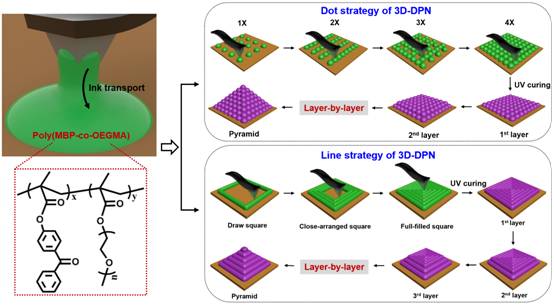Prof. Guoqiang Liu (School of Materials Science and Engineering, Northwestern Polytechnical University) and Prof. Zijian Zheng group (Institute of Textile and Clothing, The Hong Kong Polytechnic University) recently published a paper entitled “Three-dimensional dip-pen nanolithography” on Advanced Materials Technologies, 2022, 2101493. In this work, they report the development of 3D-DPN to enable the microscale 3D printing capability via designing a rapidly UV-curable liquid copolymer ink with appropriate viscoelastic properties (Figure 1). Two categories of 3D printing strategies via patterning dot and line pixels are explored, through which micrometer-high, arbitrary 3D structures could be programmed to generate. Looking beyond, this development will arouse the fundamental research and functional application interest in the field of tip-based additive 3D nanofabrication.

Figure 1. Schematic diagrams illustrating the ink transport with photo-crosslinkable copolymer ink, and 3D-DPN by dot strategy or line strategy.
A feasible approach for 3D-DPN was developed by designing a new copolymer ink and planning the construction strategy. Their developed 3D-DPN expanded the DPN technology from 2D patterning to 3D construction. More importantly, this extension may create a new 3D printing technology, which push 3D printing to miniaturization and improve spatial resolution to nanoscale. Looking beyond, compared with the mainstream 3D printing technologies, there are three potential advances reported here:
(1) that the capability of patterning soft materials on the substrate at the sub-50-nm scale improved the mineralization and spatial resolution of 3D printing.
(2) that the diversity of ink design (polymer, nanoparticle, metal precursor, biomacromolecule) enable the fabrication of multimaterial parts and the functionalization of printed structures.
(3) that the hydrated ink is more beneficial to the construction of biomaterials with good biocompatibility in the field of tissue engineering and personalized medicine.
(4) that the high throughput of 3D-DPN may be realized with the aid of large-area, cantilever-free scanning probe lithography in the near future.
Dr. Guoqiang Liu is currently a Full Professor in Northwestern Polytechnical University. He received his BEng. (2009) in Materials Chemistry and Meng. (2012) in Materials Science from Hubei University (China). Then, he completed his PhD (2015) in Materials Science under the supervision of Prof. Weimin Liu and Prof. Feng Zhou at Lanzhou Institute of Chemical Physics, Chinese Academy of Sciences. From 2015 to 2019, he worked as a Postdoctoral fellow in the Prof. Zijian Zheng’s group at Hongkong Polytechnic University. He has published more than 30 peer-reviewed papers, including Chemical Reviews, Advanced Materials, Nature Communications and Small. His research interest includes functional lubrication, bionic tribology, polymer science, and 3D nanofabrication.
Dr. Zijian Zheng is currently a full professor at The Hong Kong Polytechnic University. His research interests include surface and polymer science, nanolithography, and flexible and wearable materials and devices. He received his BEng. in Chemical Engineering at Tsinghua University in 2003, and his PhD in Chemistry at the University of Cambridge in 2007. He was a postdoctoral fellow at Northwestern University from 2008 to 2009. He was elected a Founding Member of The Young Academy of Sciences of Hong Kong.
For this work, Prof. Guoqiang Liu is the first author, and Prof. Zijian Zheng is the corresponding author. This work is supported by the Hong Kong Polytechnic University (Project YBV9), the NSFC (No. 51905433, 52175187) and the Fundamental Research Funds for the Central Universities.
The article link is as follows: https://onlinelibrary.wiley.com/doi/full/10.1002/admt.202101493
Author: Guoqiang Liu
Reviewer: Hongqiang Wang,Wei Liu